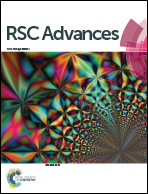A green technique to prepare uniform amine capped multi-walled carbon nanotubes to fabricate high strength, protein resistant polymer nanocomposites
Abstract
An effort has been made to produce efficient amino functionalized carbon nanotubes (CNTs) without utilizing any hazardous chemicals, with an aim to use them in biomaterials as well as in advanced polymer nanocomposites. Because it is water soluble, biocompatible and rich in primary amines, allylamine (AA) was selected for surface functionalization. Grafting was performed by a novel approach, i.e. double UV-ozone induced grafting (DUVO) process, which is absolutely eco-friendly, fast, cost-effective and highly controllable. Optimized conditions have been identified to achieve the highest degree of grafting with uniform thickness. To explore their functionality, the PAA-g-MWCNTs were incorporated into Nylon 6 and PET matrices; remarkable increases in tensile strength (34% and 78%) and Young's modulus (44% and 30%) at only 0.3 wt% filler loading were noticed due to excellent dispersion and strong adhesion with the polymer matrix. Moreover, in vitro BSA and Fb protein adsorption tests showed that the nanocomposites containing PAA-g-MWCNTs possess significantly higher surface antifouling property as compared to the neat polymers. It was also interesting to note that the antifouling property of the composites increased with increasing polymer grafting density on the CNTs. These results clearly suggest that the DUVO-PAA-g-MWCNTs would be versatile novel filler materials in the field of advanced polymer nanocomposites as well as in biomaterials.


 Please wait while we load your content...
Please wait while we load your content...